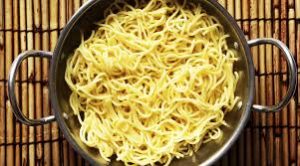Keyi Chen
CHN370W
Instant Noodle Culture in Contemporary China
White is the Korean beef bone soup, yellow are curled noodles, red is the tomato slice, green are fresh vegetables, and pink are crisp sausages. All of these ingredients are put in a small metal pot, giving off tempting scents. The dish looks so delicate by mixing various colors together that it is quite hard to believe this is just a bowl of instant noodle. With the large social and economic changes within several decades, people’s dietary habits and ideas have changed hugely. Instant noodle, as a type of fast food, is even more influenced by the process of modernization. Similar to other Chinese food, instant noodle can be regarded as a cultural indicator; more specifically, it indicates the contemporary food culture which is impacted by traditional Chinese culture, foreign cultures, domestic economic developments, and modern culture in China. In order to make this research more credible, I chose to conduct fieldwork methods, including participant observation and interview, in a supermarket and an instant noodle canteen.
To begin with, the rise and prevalence of instant noodle in the Chinese market are inseparable with traditional Chinese food culture. The origin of Chinese noodles can be traced back to more than 4000 years ago, in Han Dynasty. When noodles first appeared on the stage of history, they were initially counted as one type of Bing(饼)[1]. Later, as the territory of Han Chinese continuously was expanded, and the communication with ethnic minorities became more frequent, noodles had been spread to various regions and then developed to many different types due to regional influences, which include climates, types of staple crops, and preferred flavors of local residents. For example, noodles originated in north China are mainly made from wheat flours while rice noodles are quite popular in Yunnan Province in southwest China. Moreover, simple cooking methods make noodles even more prevalent. Flours made from local staple crops, cold and boiled water, preserved or fresh vegetables, with all these necessities, poor people from lower classes could fill their stomachs. The long history, simple cooking methods, and affordable costs have made noodles an indispensable staple food in Chinese people’s lives; as a result of which, instant noodles, as alternatives to traditional noodles, could be accepted when first launching Chinese food market. Except for the fact that the long-term dietary habit of eating noodles has laid the foundation for Chinese instant noodles, the diversified variety of Chinese noodles promotes the development of instant noodles as well. In order to promote the sales volume and compete with others, producers have kept creating new flavors which are usually intimations of traditional flavors; therefore, various kinds of Chinese noodles provides abundant resources for producers. Based on the observation in the supermarket, different noodle flavors from different regions can be clearly reflected by instant noodles: the braised beef noodle is based on Taiwan’s noodle dishes; the sauerkraut beef noodle is based on the pickled vegetables from northeast China; the hot and sour rice noodle is based on the famous dish in Sichuan Province… Nowadays, as the continuous consumption upgrading, the sale of instant noodles has been keeping declining for several years[2]; however, the brand Master Kong’s sale keeps growing. The reason behind is that the brand keeps adding new flavors that come from traditional Chinese dishes, such as chicken stewed with mushrooms and spicy oil noodles(油泼辣子面)[3].
Furthermore, because of the convenience and traditional tastes, Chinese instant noodles are becoming more and more popular in foreign markets as one of the symbols of Chinese food culture[3]. From these facts, we can find that the wide variety of instant noodle flavors, which are results from the traditional Chinese food culture, have made the market diversified and push the development of instant noodles forward.
Except for traditional Chinese food history and culture, foreign food cultures also impact Chinese instant noodles a lot. The impacts can be divided into two categories: impacts from western fast-food culture and impacts from other Asian food cultures. Firstly, the fast-food culture from western countries makes it easier for Chinese people to alter their dietary concepts. After the economic open-up in 1978, more and more foreign companies, including foreign food franchises, began launching in the Chinese market, one of the biggest markets in the world. With the entering of KFC in 1987[4], the concept of fast food was also brought to Chinese people’s lives. In the past, people had been used to go to traditional “sit down” restaurants and wait for the food to be cooked. However, the appearance of fast food has allowed people to save time for waiting by selling prepared food or cooking semi-prepared food in just a few minutes. The concept of instant noodles is the same as that of burgers and fried chickens. Buying a bag of instant noodle allows people to save the time that is used to waiting for chefs to cook a bowl of noodle. This concept has a large difference with the traditional noodle-eating habits in the past thousands of years; nevertheless, as the fast-food culture brought by foreign fast-food restaurants had already changed young people’s concepts at that time, the appearance of instant noodles in mainland China was not too hard to be accepted. Moreover, instead of buying cooked fast food in restaurants, nowadays, consumers like adding their own preferred ingredients when cooking to make instant noodles more nutritious and delectable. This characteristic actually reflects the traditional Chinese belief of balancing nutrition and flavors in one dish. Mixing fast-food culture with traditional food culture makes instant noodles even more popular among consumers among different ages.
Secondly, instant noodles in the contemporary Chinese market are influenced by several other Asian food cultures. At present, we can see various imported instant noodles from other Asian countries nearby. According to the observation in the supermarket, imported instant noodles occupy almost half of the shelves; in the instant noodle canteen, approximately 95 percent of instant noodles are imported. These imported noodles are from famous foreign brands like Nissin and Samyoug, including different flavors that intimate noodle dishes in East and Southeast Asian countries: Japanese pork bone soup ramen, Japanese yakisoba, Korean kimchi ramen, Malayan laksa rice vermicelli, Thai tom yum ramen… Buying these imported instant noodles makes people not need to look for authentic foreign noodle dishes in restaurants anymore. Although the prices of these products are higher than those domestic products, the price difference is not so big that it is still affordable to most consumers. Furthermore, importing foreign instant noodle brands has pushed the development of domestic brands. In order to be more competitive in the increasingly fierce competition, domestic producers launch “foreign noodle dishes.” One apparent example is the brand–Uni-President(统一). We can easily find foreign flavors as Japanese pork bone soup ramen, Japanese miso ramen, and coconut chicken soup noodle in the instant noodle series called Tang Da Ren(汤达人). It is interesting to find that Chinese noodles influenced the rise of noodles in neighboring countries by communication and immigration in the past, while neighboring countries have enriched the contemporary Chinese instant noodle market both directly and indirectly, using noodle dishes developed under their own cultures. Behind the interaction of noodles is the interaction of different cultures.
While discussing both domestic changes in food culture and impacts from foreign food cultures, we can never ignore the effects of huge economic changes in decades. An essential changing point is China’s economic reformation and open-up. The open-up of mainland China’s market opened a door for the entering of foreign companies. Also, the booming economy improved people’s living standards largely; therefore, improving living standards provided more channels, such as magazines and televisions, to learn more about other cultures. The changes in media and market subtly made Chinese people more open-minded. As a result, instant noodles, as an invention from Japan and a mixed product of eastern and western culture, could be accepted by the public without many obstacles. In fact, the Chinese instant noodle market was established quickly and kept thriving from the 1990s to recent years. The new eating concept, which focuses on convenience and quickness, and good tastes are still attractive to many consumers nowadays. However, as the Chinese economy keeps growing rapidly, the consumption level and living standards keep being upgraded as well; thus, the sales of instant noodles is gradually declining in recent years. In the 1990s, the price of instant noodles was suitable for the middle class[5], but just about 20 years later, in 2014, the growing middle class began losing interests in instant noodles and consider them cheap and unhealthy[6]. Flourishment in economics has improved all aspects of Chinese people’s lives. When poverty is not a problem for most families, people begin to pay attention to knowledge and health. Due to more advanced access to information, the unhealthiness of instant noodles has been easily exposed to consumers. Because of the improved financial conditions, instant noodles, with an average price lower than 10RMB, are quite cheap in consumers’ eyes, and the public is able to replace them with much healthier and more expensive food easily. Moreover, the arisen online ordering and food delivery services provide consumers with both healthier and convenient eating experiences; as a result of which, the instant noodle market has been impacted a lot. In general, either the prosperity or the downturn of the instant noodle market has a close relation with China’s economic growth.
Even though the whole instant noodle market is turning down at present, there is a new way of eating instant noodles arising owing to the economic growth. Instant noodle canteens, a type of restaurants that sell well-cooked instant noodles to customers, created another new idea of eating–serving instant noodles in the way of serving traditional noodle dishes in restaurants as the scene depicted in the beginning. The idea was quite popular among young people who were born in the 1990s and 2000s. Based on the observation in the instant noodle canteen, it is obvious that almost all customers in the restaurant are young. According to the waiter in the canteen, most of their customers are people born in the 1990s; during the summertime, students born in the 2000s join in to try the “new” instant noodles as well. By interviewing customers sitting in the canteen, we could find two main objectives of eating in such an instant noodle restaurant. The first one, also the most common one, is to try new things and see how they differ from self-cooked instant noodles. Another one is that some consumers consider the canteen as a normal noodle restaurant, but they can have much more choices of flavors. The rise of this kind of instant noodle restaurants all over the country can not be separated from modern Chinese culture, which is a result of economic growth. Because of rapid economic growth, technologies are much more developed than before; then, the Internet became a common and indispensable tool for people’s daily communication and entertainment. The pursuit of delicacy due to material wealth and fast propagation speed of information due to advanced Internet bring out the “web celebrity” culture. Innovation and delicacy are the main cores of this type of culture. As we can see in the instant noodle canteen, the decoration is in a contracted Japanese style, which is considered delicate by many young people, and the instant noodles served are beautifully arranged. Different sets of instant noodles with various toppings are categorized into different levels, named after the levels in a famous mobile game called King of Glory. Not only the concept of eating instant noodles but also detailed ideas about all aspects of the canteen reveal the creativity under modern culture. One problem for both the canteens and the “web celebrity” culture is the ephemerality. Owing to the rapid propagation speed of information in the cyber world, lifestyle trends are changing day by day, and the old trends can be easily and quickly replaced new trends. In instant noodle canteens, except for the delicacy and creativity, there is nothing left to be catchy since the tastes of instant noodles here are almost the same as those cooked at home. Therefore, many customers would go to instant noodle canteens for just once, taking pictures and posting them online to show they keep up with trends. Intriguingly, modern lifestyle and internet culture have changed a type of fast food back to traditional dishes somehow but cannot bring its prosperity back due to the tide of economic growth.
In conclusion, the cultural and social effects behind instant noodles are not as simple as the cooking methods. The current situation of instant noodles in China is the result of influences from multiple aspects. Domestic and foreign cultures, traditional and modern culture, and, most importantly, economic changes have commonly impacted the Chinese instant noodle market. From the prosperity to the downturn of instant noodles’ development, we can see how people’s thoughts and lifestyles, reflected by simply one type of food, under the tides of changing society and culture. In the future, we can expect that these aspects can continuously influence not only instant noodles but also Chinese food culture.
Bibliography:
- Zhang, N., & Ma, G. (2016). Noodles, traditionally and today. Journal of Ethnic Foods,3(3), 209-212. doi:10.1016/j.jef.2016.08.003
- S. A. (2017, December 20). BBC News. Retrieved from https://www.bbc.com/news/business-42390058
- Chen, G. (2018, March 23). From American Cola to Chinese Instant Noodles. Retrieved from http://www.iheima.com/article-167644.html
- J. K. (2013, July 16). The Guardian. Retrieved from https://www.theguardian.com/world/2013/jan/04/china-fast-food-pioneer
- China Science and Technology Information. (1995). Instant Noodle Market Research.
- L.H. (2017, August 21). South China Morning Post. Retrieved from https://www.scmp.com/business/companies/article/2107540/chinas-growing-middle-class-lose-appetite-instant-noodles



